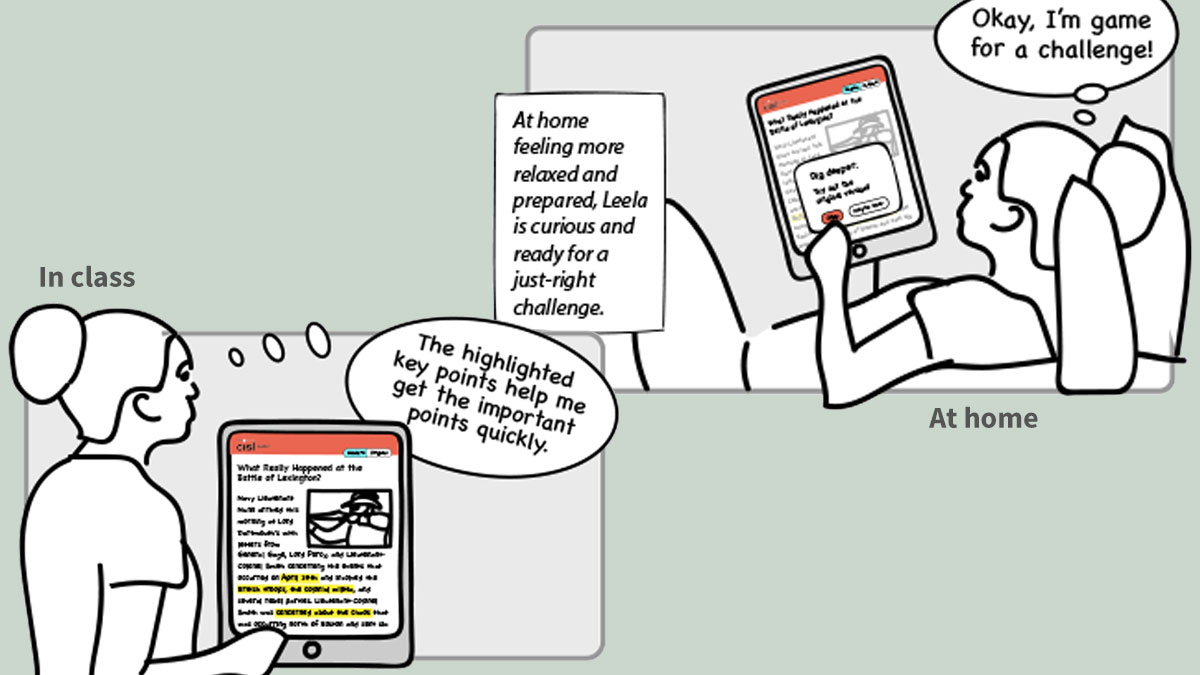Adaptivity & Expert Learners

The adaptive features in Clusive will provide recommendations for supports and content that individualize learning with the ultimate goal of creating expert learners.
The CISL project leverages adaptivity to address the ultimate goal of Universal Design for Learning: to build expert learners. An adaptive learning environment customizes content and supports in response to individual learner needs and preferences. Clusive supports this by making data-driven recommendations transparent for learners.
Clusive wants to put the control in the hands of learners themselves, in order to build expert learners! This is done by:
- Prompting and supporting learners in exploring their preferences
- Using information from learners’ prior actions and work products to suggest and deliver helpful supports and content
- Giving learners agency over how and when adaptive supports and content appear
- Building self-awareness by explaining adaptive recommendations and changes
Try out the adaptive features in Clusive
What does adaptivity mean to you?
The creators of Clusive share their thoughts on what adaptivity means from their perspective in the design and implementation process.
User Experience / Design: Kim Ducharme

“In my mind, the best kind of adaptivity means the system knows me seemingly better than I do, at least at first. It notes my patterns and preferences, delivers me a just-right experience both seamlessly and with my full knowledge of what’s going on behind the curtain and why, at least when and where I want it. The best kind of adaptive system scaffolds my learning experience and, together with me, releases the training wheels as I learn where to reach for what I need—as I gain a better command of what works best for me.”
Kim Ducharme, CAST Director of Educational User Experience Design
Research: Bob Dolan

“Expert learners decide for themselves which content, contexts, and supports work best. Even when curricula, instruction, and materials adhere to UDL principles and provide flexibility, it can be daunting for students to make effective choices. An excellent way to support students in building the metacognitive skills foundational for expert learning is through modeling. This is where effective adaptive learning systems can best operate—and why they must operate transparently. Adaptive learning solutions that indicate why choices and recommendations are made can scaffold students in making effective choices. Allowing students to override system decisions further provides opportunities for self-agency. In the end, students are provided not only with improved opportunities for immediate learning goals, they’re supported in becoming expert learners.”
Bob Dolan, CAST Senior Innovation Scientist
Instructional Design: Kristin Robinson
“In biology, an adaptive feature is something that allows a living thing to thrive and grow. I think of that definition when I consider adaptivity in Clusive. Adaptivity means that learners have the unique set of features that allow them to grow, and these change as a learner and their environment changes. And UDL adaptivity means that the learners see, clearly, how they are learning, what things they need to grow, and how their challenges and strengths change over time and conditions.”
Kristin Robinson, CAST Instructional Designer & Research Associate

A game-like word challenge gathers information about users and informs Clusive recommendations.
What adaptivity features does Clusive currently contain?
Clusive’s adaptive dictionary and glossary supports students in understanding and learning from their readings. When learners open a resource, they can do a game-like word challenge that evaluates their current word knowledge. While reading, they can look up words, view their previous word look-up activity, and add any word or term to their personal Clusive Word Bank—a full list of words they’ve collected. All of this informs subsequent adaptivity, including text challenge level.
Adaptive tips and suggestions provide just-in-time discovery and guidance where and when learners need it, alerting them to many of the features that make Clusive special.
What adaptivity features are we working on now?
- Refined text adaptivity. Information gleaned by a skills discovery tool, combined with learner goals, preferences, and activity, will help Clusive recommend a just-right challenge for each learner. Clusive can provide texts at different complexity levels, as well as modernized versions of text. What's next? Text versions may also include outlines, highlighted main ideas, summaries, annotatations, translations, and more. And as always, learners will know why a recommendation is made and can select other text versions.
- Preference-setting adaptivity. Periodically, Clusive will suggest learners try different accessibility preference settings based on their individual strengths, needs, and goals. In addition, Clusive will ask learners for their reaction to the settings to inform future recommendations.
- Learning tools adaptivity. Based on use patterns and affect reporting (e.g., how learners currently feel about resources and their learning progress), Clusive will occasionally prompt learners to try learning features. A friendly message such as, “Try out this feature." can encourage a learner to explore features that support their learning progress and promote learner agency to make choices that work best for them. Learner feedback will also help inform future learning tool recommendations.
- Content recommendations. These will be based on topic preferences, affect reporting, reading skill level, and stated goals.
